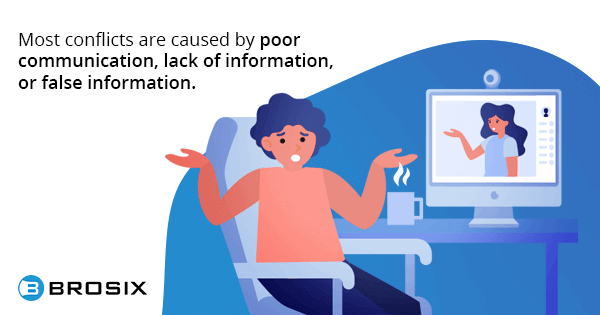Conflicts can happen within a company, whether you are working in an office or not. It’s more likely to happen when you put people together in an office, but it can also happen even when your team is working remotely.
The rise of remote job websites is proof that remote and flexible working has become the new normal. Even when people don’t often see and communicate in this kind of arrangement, however, problems can still arise.
As a way to prevent a hostile environment in a virtual workplace, internal communication is important. Strengthening internal communication and learning to resolve any conflict in the past or future is essential for your team to move in a forward direction.
While some businesses thrive even without a solid and effective internal communication protocol, it’s best that you take the opposite route. Why wait for conflict to happen before you implement policies for effective internal communication?
[bctt tweet=”Workplace Conflict Resolution: How to Resolve Conflicts Within Remote Teams”]
If you are a leader or project manager, it is important to learn about internal communication to prevent conflict and find solutions to resolve the conflict between team members.
Before we get into the list, here is a quick definition of internal communication.
Internal Communication in Remote Teams
While remote teams offer the flexibility to work from anywhere, having employees scattered in different locations makes communication more important (which is one of the top skills employers look for in a remote employee). Conflict tends to occur with poor communication. Different people have different opinions and personalities, after all. Not everyone will always get along. There will be instances when their opinions clash.
What is internal communication in a remote workplace?
It is a flow of messages that contain useful information among the individual team members. It can be a group of developers and programmers of apps or software or writers and editors for an online publication.
Internal communication in a remote workplace happens mostly through team communication tools, video conferencing apps, email, and project management software.
Communication can either be formal or informal, depending on the medium. Sometimes emails are more formal than instant messaging apps, but it is better to be more formal when talking about work. It allows the team to be on-point at all times, although it is still a good idea to have channels where team members and managers can communicate on a personal level.
From my personal experience, Brosix is a great option for managing a team. Not only can it help your company feel like they are in an actual office, it could even help solve communication problems that lead to conflict.
Take note of some of the best practices for internal communication and implement it in your own company. Doing so will help minimize miscommunication, misunderstanding, and other causes of conflict.
Because conflict is bound to happen, you should be equipped with the right resolution strategies.
7 Ways to Resolve Conflict within Remote Teams
1. See Conflict as an Opportunity to Define Acceptable Behavior
This opportunity will allow you to set boundaries and define what behavior is accepted in the workplace.
When starting any business or managing an existing remote business, there are a couple of things that you want to do but don’t really know how to initiate it such as setting boundaries and defining acceptable behavior.
Bad as this may sound, but experiencing conflict is an opportunity to set and define behavior that is acceptable. This is not only limited to attitude but also includes knowing boundaries such as giving clear job descriptions to avoid people stepping on each other’s toes.
Make sure that you:
- Create a framework for decision making.
- Make your framework encouraging for team building.
- Publish a memo or statement through email or the current messaging app you are using with your team.
- Make sure that you send the memo to each of the team members individually, and not through a group message. Also, make sure that you give it to everyone; not just those involved in the recent conflict.
- Send the new guidelines to newly hired individuals to avoid conflict in the future.
Embracing conflict instead of avoiding it is one of the best approaches. This will give you an opportunity to employ tactics when training remote employees.
2. Look for the Root Cause not for Someone to Blame
It may be a knee-jerk reaction to ask who started what–but take a pause. The disagreement may have erupted from miscommunication or project details lost during transmission.
It’s important to show your team that pointing fingers will only worsen the situation. A more productive approach is to find a resolution and then move on. As a team manager, it is better to not concentrate on the mistakes made but to focus more on how to correct them.
Resolving conflict is not about one party winning, but about accepting different views. Taking sides will only cause people to remain adversaries. Using these resolution techniques will increase the possibility of a mutual benefit and positive outcome for you, the company, and your goals.
Sometimes the cause would be the language and cultural barriers of remote employees. Since they are located in different locations all over the world, overcoming cultural barriers is an essential part for a remote team to succeed.
3. Make Time to Talk About the Conflict with Parties Involved
On-going conflict can affect the productivity of team members, so it is better to resolve it quickly than let it fester. You want everyone to be working together not against each other. In a remote setting, scheduling time to connect with fellow coworkers is critical.
Make sure that you take the time to speak to the parties or individuals involved in the conflict and hear both sides. You cannot really resolve something without knowing each side of the story.
Also, when you learn about what happened, try to avoid telling them how you felt, what they said, or they did. The misunderstanding might trigger emotions and anger that will worsen the conflict.
Before meeting with them, make sure that the conversation has a goal you want to reach. The conversation can go anywhere, so make sure you list down the points you want to discuss to be more efficient.
Make sure that you do not talk about things that are not related to the matter, or things that already happened in the past. Keep your focus on the now, and how to solve the current problem.
Having a goal-oriented conversation gives you a better chance of resolving the conflict faster and more successfully.
Talking about conflict is easier said than done. You can start and get straight to the point head-on, but it is also important to warm them up, allowing them to speak more honestly. Asking for a face-to-face meeting can be intimidating for each of the parties in the conflict, so make sure you let them know what the meeting is about beforehand.
When setting up a video meeting, timing is important. So make sure you discuss it with each party and discuss the best time for them to meet. However, do not wait too long, as you may lose the opportunity to resolve it.
4. Listen and Wait for your Turn to Speak
When meeting face to face, or in the case of remote jobs, via video chat, make sure that you hear each side clearly first.
Do not interrupt someone while they’re explaining their side. This could discourage them from speaking honestly, resulting in further miscommunication or misinformation, like what might have caused the conflict in the first place.
Avoid talking about the problem to other people who are not involved. It will lead to rumors and cause people to take sides.
The remote workplace means that people communicate through instant messaging apps, and reading something is commonly misinterpreted than actually hearing someone actually speak. Things can get a little out of hand.
Make sure to call the persons involved so you can speak and listen to their side verbally, allowing you to break down what started the conflict and get to the bottom of it.
Also, make sure you and your team are using a secure chatting app, to keep all conversations and sensitive information safe.
5. Admit and Take Responsibility of Your Wrong Doings or State What You Could Have Done to Avoid the Conflict
For those who are involved in the matter. Make sure you don’t let your emotions get ahead of you.
You do not have to take this step immediately, but do find the right moment to admit and take responsibility if you were wrong.
If you are having trouble seeing what you did wrong, then it is not the right moment to talk about it. It is better to reflect and gather your thoughts first before meeting with the people involved.
Once you realize that you had a part in the conflict, make sure you:
- Admit your mistakes.
- Take responsibility for the mistakes you did, and
- State things that you could have done to avoid the conflict in the first place.
Whether it is your fault or not, you still had something to do with the rise of the conflict and did not stop it from the root, so make sure you always reflect on what you could have done to avoid it.
6. Assess the Person’s Behavior and not the Personality
For team managers, it is important to assess someone’s behavior at work and not for who they are. When you bring personality into the matter, the conflict would become more personal and less work-related.
Judging someone based on their personality will create a negative or toxic atmosphere in the workplace. Focusing on someone’s personality is not a good road to take as it undermines workplace conflict resolution techniques, making them unsuccessful.
The members might even feel that the manager can be too condescending. When you meet via video chat, make sure you address the conversation with neutrality.
Focusing on one’s personality traits is a conflict resolution technique that has a higher risk of failing.
7. Resolve, Address, Forgive and Move On
When trying to resolve a conflict, it can escalate to a point that you feel that everything is going wrong. Do not lose hope because there is nothing you can’t solve.
Avoiding problems like this can only make things worse, so look at it in the face and find a solution. After resolving the conflict successfully, make sure that both parties are at peace, and are working to get past what happened. If one or all involved parties hold a grudge, working harmoniously is next to impossible.
It is important for them to apologize for their wrongdoings, but as long as the apology is implied and forgiveness is on the table, it should be good.
The company, the manager, and the parties can now move on, and be more productive and work as a team. Workplace conflict resolution is not as easy as it sounds, but it is doable.
Now, you can learn from this conflict and apply better ways to avoid and to resolve them in the future by creating space and have open channels for addressing future problems.
Conclusion: Application of Conflict Resolution Techniques
When trying to resolve conflict in a remote or physical workplace, always remember the process, and don’t expect that you can solve it in a flash.
Most conflicts are caused by poor communication, lack of information, or false information, which is why it is very important to communicate with conflicting parties before trying to resolve anything.
Sometimes, emotions take the best of us and drive us to make decisions that are not helpful at all. It can be as destructive as the conflict itself.
However, no matter how good the communication process is within a remote team, conflict between individuals or teams is inevitable.
[bctt tweet=”Workplace Conflict Resolution: How to Resolve Conflicts Within Remote Teams”]
Just remember that the key to workplace conflict resolution is always effective communication and to not let emotions get in the middle of things. Experiencing conflict also helps you learn from mistakes in the past, allowing you to be ready with solutions for future problems.










